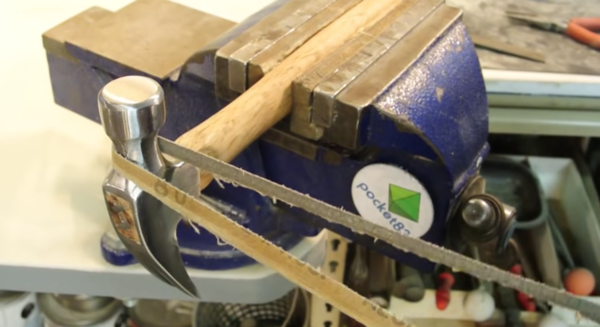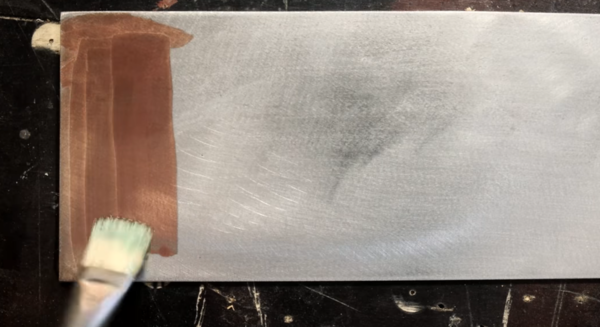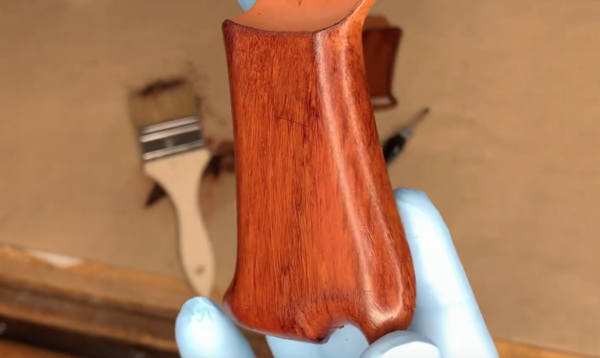Tuning Up a Harbor Freight Hammer
Gareth's Tips, Tools, and Shop Tales - Issue #82
Tuning Up a Harbor Freight Hammer

Hammer time.
In this newsletter, I’ve frequently talked about buying lots of pencils, rulers, scissors, and other relatively inexpensive go-to tools and stashing around the shop (and home). But this commonly-used tool saturation is not practical for more expensive tools. Or is it? Pocket83 bought some $3.99 Harbor Freight rip hammers to keep throughout his workshop. Before he put them into service, he spent some time “tuning” them up. He rounded off the hard edges of handle and heads, sanded and re-finished the handles, reinforced the eye hole (where the head and handle attach), and he added rubber grips using recycled inner tubes.
Paint-On Copperplating?

What is this sorcery?
In a follow-up to her recent video where she electroplated the gas tank of her motorcycle with copper, Laura Kampf decided to try a much easier platting method of simply painting on a copperplate solution. She saw a video demonstrating the technique and wanted to try it out. It appears to work. Amazing. As she points out, this could lend itself to all sorts of applications.
The Duh Department
I want to start a new periodic feature where I mention tips that are commonly known but may bear repeating. Introducing “The Duh Department.”
I’ve been cleaning out a lot of my old tech and stored junk. Even though I know to remove batteries from things being storing, I am shocked at how many things still have (now corroded) batteries in them. So, here’s a reminder. Add it to your to-do list. Go through your house and garage and check every battery-powered thing you’re not currently using and remove their batteries.
Faux Woodgrain for 3D Printing

Looks like wood to me.
I love doing faux finishes. These techniques can come in handy when trying to make a piece of 3D printed plastic look like wood or stone or metal. In this Off Earth video, Darrell shows how you can achieve a pretty realistic faux wood finish by using a mid-tone brown spray paint basecoat and various shades of brown alcohol ink pens.
Getting Bubbles Out of Resin

Bubble, bubble, toil and trouble.
If you don’t have a pressure pot, getting bubbles out of casting materials can be a pain in the butt. This CrafsMan video offers 7 ways to remove bubbles from your casts.
Shop Tales
In response to my item in the last newsletter about drafting triangles, legendary toy design, Bob Knetzger, shared this funny little anecdote (and a tip).
In industrial design school, I had an instructor, Todd Smith, who was a very talented renderer. He would give us demos and workshops using colored Canson paper, spirit Magic Markers™ (the stinky ones in the little glass bottles), NuPastel chalks, Prismacolor pencils, and White Out (for making the white, sparkling highlights on chrome, which we lovingly called “bird shit”). We learned to render surfaces like woodgrain, painted steel, glass, chrome, etc. in our realistic drawings of cars, pencil sharpeners, and vacuum cleaners. In one demo, he Socratically asked us “You know why a triangle is your best drawing tool, right?” We all guessed that the 30/60/90 angle was useful in perspective layouts…? No. Cuz the 45 degree triangle helps divides lengths by 2 visually? No. Putting his fingers through the opening to hold the 90 degree corner: “…because it’s a straight edge with a HANDLE!”
Draftsmen always keep the triangle flat on the paper, sliding them to use the edges along T-squares, parallel rules, and other triangles. Renders NEVER lay the triangle flat on the paper (that would instantly smudge the delicate pastel chalk!)—they hold the triangle up at an angle away from the paper surface and only touch the triangle’s drawing edge to the paper. (At least they did back in the olden days….)
Shop Talk
In response to my somewhat controversial post about CA glue having a shelf-life, I’ve had two readers volunteer to do some testing to see if there really is an appreciable difference between old and new CA glue. One reader is a materials scientist and one is a mechanical engineer by education. We are currently working on putting together a testing procedure that both of them can follow. It will be interesting to compare the results. stay tuned. If you have any thoughts on this subject, please message me.
(Gareth’s Tips, Tools, and Shop Tales is published by Cool Tools Lab. To receive the newsletter a week early, sign up here. — editors)






